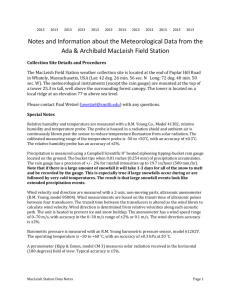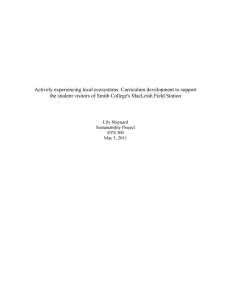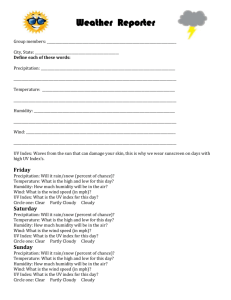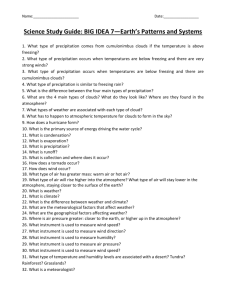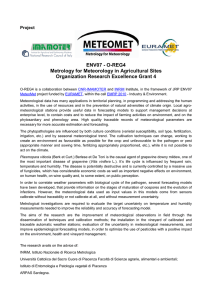Data Information 2011
advertisement
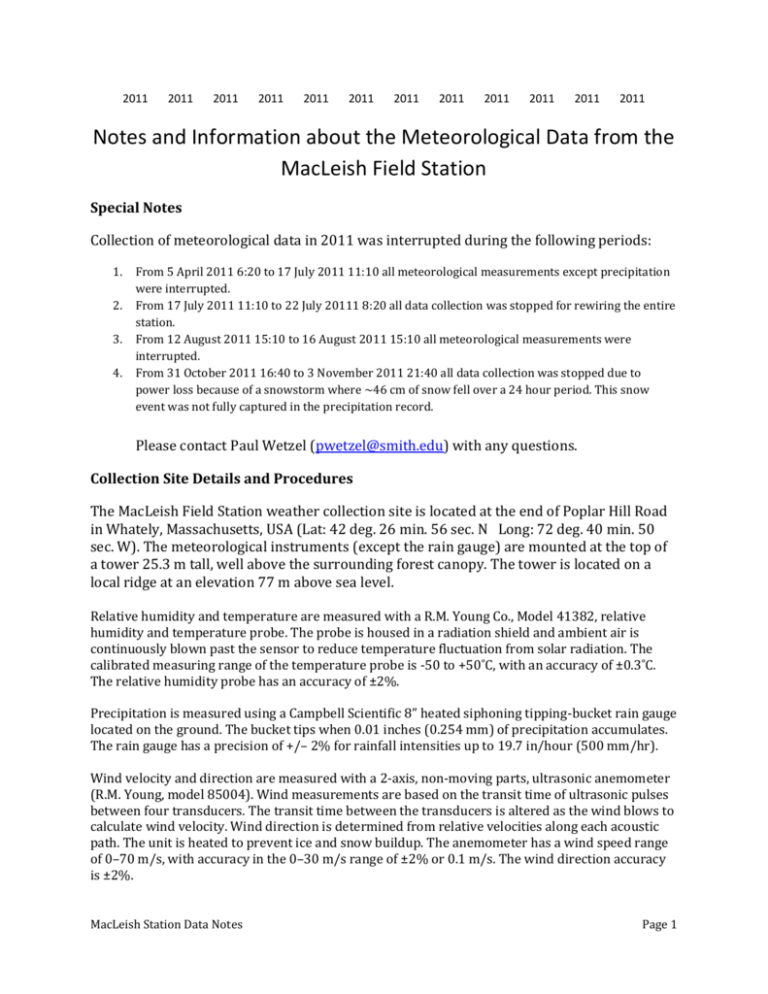
2011 2011 2011 2011 2011 2011 2011 2011 2011 2011 2011 2011 Notes and Information about the Meteorological Data from the MacLeish Field Station Special Notes Collection of meteorological data in 2011 was interrupted during the following periods: 1. 2. 3. 4. From 5 April 2011 6:20 to 17 July 2011 11:10 all meteorological measurements except precipitation were interrupted. From 17 July 2011 11:10 to 22 July 20111 8:20 all data collection was stopped for rewiring the entire station. From 12 August 2011 15:10 to 16 August 2011 15:10 all meteorological measurements were interrupted. From 31 October 2011 16:40 to 3 November 2011 21:40 all data collection was stopped due to power loss because of a snowstorm where ~46 cm of snow fell over a 24 hour period. This snow event was not fully captured in the precipitation record. Please contact Paul Wetzel (pwetzel@smith.edu) with any questions. Collection Site Details and Procedures The MacLeish Field Station weather collection site is located at the end of Poplar Hill Road in Whately, Massachusetts, USA (Lat: 42 deg. 26 min. 56 sec. N Long: 72 deg. 40 min. 50 sec. W). The meteorological instruments (except the rain gauge) are mounted at the top of a tower 25.3 m tall, well above the surrounding forest canopy. The tower is located on a local ridge at an elevation 77 m above sea level. Relative humidity and temperature are measured with a R.M. Young Co., Model 41382, relative humidity and temperature probe. The probe is housed in a radiation shield and ambient air is continuously blown past the sensor to reduce temperature fluctuation from solar radiation. The calibrated measuring range of the temperature probe is -50 to +50˚C, with an accuracy of ±0.3˚C. The relative humidity probe has an accuracy of ±2%. Precipitation is measured using a Campbell Scientific 8” heated siphoning tipping-bucket rain gauge located on the ground. The bucket tips when 0.01 inches (0.254 mm) of precipitation accumulates. The rain gauge has a precision of +/– 2% for rainfall intensities up to 19.7 in/hour (500 mm/hr). Wind velocity and direction are measured with a 2-axis, non-moving parts, ultrasonic anemometer (R.M. Young, model 85004). Wind measurements are based on the transit time of ultrasonic pulses between four transducers. The transit time between the transducers is altered as the wind blows to calculate wind velocity. Wind direction is determined from relative velocities along each acoustic path. The unit is heated to prevent ice and snow buildup. The anemometer has a wind speed range of 0–70 m/s, with accuracy in the 0–30 m/s range of ±2% or 0.1 m/s. The wind direction accuracy is ±2%. MacLeish Station Data Notes Page 1 Barometric pressure is measured with an R.M. Young barometric pressure sensor, model 61202V. The operating temperature is –50 to +60 ˚C, with an accuracy of ±0.3 hPa at 20 ˚C. A pyranometer (Kipp & Zonen, model CM 3) measures solar radiation received in the horizontal (180 degrees) field of view. Typical accuracy is ±5%. Data Format Files containing 10 minute data are organized in the following column order: 1. Date/Time (24 hour clock) 2. Date/Time (24 hour clock) in decimal format 3. Air Temperature (˚C) 4. Wind Speed (m/s) 5. Wind Direction (degrees) 6. Relative Humidity (%) 7. Atmospheric Pressure (mb) 8. Solar Radiation (watts m-2) 9. Precipitation (mm) Files containing daily data with maximum and minimum values and the times that those values happened during the day are organized in the following column order: 1. Date/Time (24 hour clock) 2. Date/Time (24 hour clock) in decimal format 3. Mean Air Temperature (˚C) 4. Max. Air Temperature (˚C) 5. Time of Max. Air Temperature (˚C) 6. Min. Air Temperature (˚C) 7. Time of Min. Air Temperature (˚C) 8. Mean Wind Speed (m/s) 9. Mean Wind Direction (degrees) 10. Max. Wind Speed (m/s) 11. Time of Max. Wind Speed (m/s) 12. Min. Wind Speed (m/s) 13. Time of Min. Wind Speed (m/s) 14. Mean Relative Humidity (%) 15. Mean Atmospheric Pressure (mb) 16. Mean Solar Radiation (watts m-2) 17. Total Daily Precipitation (mm) In the event of ties for the timing of minimum and maximum events, the last time during the day that the event occurred is the value recorded. MacLeish Station Data Notes Page 2 Time Correction All data from the MacLeish Station must be corrected to the local time. Data at the MacLeish meteorological station is collected on Greenwich Mean Time (GMT) which is five hours ahead of local time during periods of the year when local standard time is invoked. During daylight savings time GMT is four hours ahead of local time. The calendar and Julian dates of standard and daylight savings times are given in the table below. Therefore to calibrate the data in the data file to local time, subtract 5 hours from the recorded time during periods of standard time and subtract 4 hours from the recorded time during periods of daylight savings time. Year Daylight Savings Time Begins Daylight Savings Time Begins (Julian Date) Standard Time Begins 2009 2010 2011 2012 2013 2014 2015 March 8 March 14 March 13 March 11 March 10 March 9 March 8 67 73 72 71 69 68 67 November 1 November 7 November 6 November 4 November 3 November 2 November 1 MacLeish Station Data Notes Standard Time Begins (Julian Date) 305 311 310 309 307 306 305 Page 3 Julian Date Calendar Perpetual MacLeish Station Data Notes Page 4 Julian Date Calendar For Leap Years Only Recent and future leap years: 2004, 2008, 2012, 2016, 2020, 2024, 2028 MacLeish Station Data Notes Page 5
